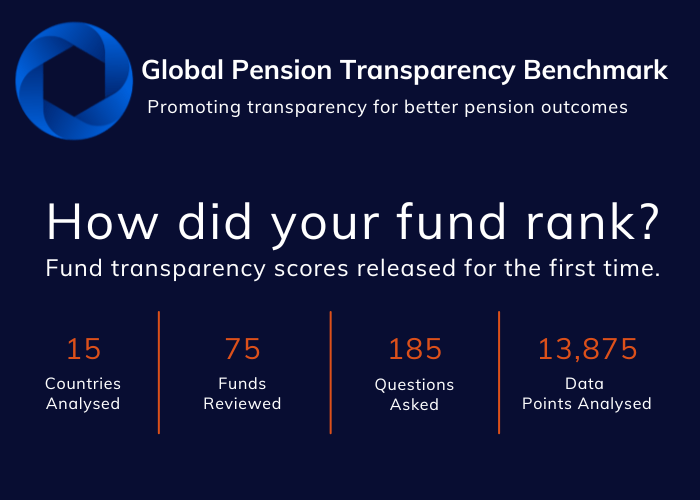The Global Pension Transparency Benchmark revealed the need for much improved transparency among pension fund public disclosures across the globe. But there were some notable best practice examples among pension funds globally. So who were they?
The Global Pension Transparency Benchmark provides a clear picture of the transparency of pension fund disclosures across cost, governance, performance and responsible investment. But as well as demonstrating the current state of disclosure, it also highlights the global best practices through examples of specific funds’ practices revealing detailed analysis of the funds that stood out.
Cost
Research based on CEM’s benchmarking database clearly shows that funds with cost-effective investment operations generate better net returns and value added than funds that don’t.
CEM says that clear and complete public disclosure of costs leads to better cost management, and that cost transparency is also important for building trust with stakeholders. It is also true that investments that have the lowest level of cost transparency – where fees are netted from the investments directly – are often the most expensive ones. So transparent cost disclosure is important for pension funds.
The Dutch funds stood out in the disclosure of cost, with the top four scores held by Dutch funds.
An example of best practice from both PFZW and ABP, was in the reconciling of financial statement cost numbers, where they showed why financial statement costs differ from what is used elsewhere in their annual reports.
(For stories on PFZW/PGGM and ABP/APG visit the Asset Owner Directory here).
The GPTB also demonstrates that following accounting practices for audited financial statements as well as also using other parts of the annual report to provide the complete cost picture is an example of best practice. This means including costs and fees that are netted directly from investments, at least in other report sections (eg management discussion and analysis, key performance indicators).
The Royal Bank of Scotland Group annual report is an example of how to supplement financial statement costs and provide stakeholders with an analysis of total investment management fees.
With regard to investment fees Royal Bank of Scotland monitors investment management fees closely, including fees deducted at source, to determine whether it is getting value for money from its investment managers. It monitors fees in absolute terms as well as comparing fees to the value added over the benchmark.
Governance
Governance and Organisation scores were more closely correlated with overall scores than any of the other factors.
Best practice is for the skills and competencies possessed by the board to be disclosed and contrasted against desired skills and competencies.
The five largest Canadian funds, assessed in the research, had the highest average score for this factor. But the GPTB also highlighted three best practice examples from other parts of the world when it comes to governance disclosure.
Danish fund ATP’s 2019 annual report, outlines competencies in plain language in a way that is easily relatable to their current board position. This information is supplemented with the board members’ educational qualifications and other directorships providing a full picture of the skills possessed by each board member.
The UK’s Universities Superannuation Scheme publishes a corporate governance framework policy on its website which includes full job descriptions for prospective board members which provides full clarity as to the type of skills and competencies desired.
Australian superannuation fund QSuper reports annually on its compliance with the Australian Institute of Superannuation Trustees’ Governance code.
The desired board competencies can be viewed as well as whether their board members have these competencies, and their relative skills in each.
(For stories on ATP, USS and QSuper visit the Asset Owner Directory here).
Performance
Most pension fund returns come from asset mix decisions but there is also has an opportunity to add value through active funds management decisions. Stakeholders are keenly interested in knowing and understanding returns and value added. The GPTB highlighted several best practice disclosure examples for reporting of returns and value added.
In addition to an extensive annual report, CalPERS produces a three-pager that provides a high-level summary of key results for the time-pressed reader. The total fund return includes current year, intermediate and long-term returns.
The COVID 19 downturn is a recent and vivid example of how markets can move abruptly and dramatically and pension fund stakeholders can become anxious and concerned about the security of pensions. CDPQ provided an excellent interim performance update on its website that put the downturn in context and outlined an action plan for mitigating its impact.
In its 2019 comprehensive annual financial report, CalSTRS includes a table with asset class and related benchmark returns for 1, 3, 5 and 10-year time periods. The returns are clearly stated as net of investment fees and time weighted, including a more detailed description of the time-weighted rate of return calculation.
In the investment performance area of its website, OTPP includes information on benchmarks. The discussion includes important context on why OTPP uses benchmarks and how performance relative to them should be interpreted. Total fund net return, benchmark return, and value added are shown for a range of time periods and a list of asset class benchmarks is also provided.
(For stories on CalPERS, CDPQ, CalSTRS and OTPP visit the Asset Owner Directory here).
Responsible investment
Funds with a supplementary responsible investing report or a separate section in their annual report typically have much better RI disclosures than those that do not. European countries – Sweden, the Netherlands, Denmark, and Finland – earned the four highest scores on our RI factor. They stood out for two reasons: funds in these countries generally have more highly developed responsible investing efforts; and they had excellent disclosures communicated via these supplemental RI reports or dedicated annual report sections.
Providing separate sections or standalone RI reporting allows funds to clearly communicate their RI strategy and progress as well as to highlight the specific RI themes they are focused on. It also helps stakeholders to quickly and easily assess whether a fund takes RI seriously and what is being done.
The Finnish fund, Elo’s responsible investing initiatives were incorporated into its annual report and Elo provided RI details by focusing on: investing, climate, customers, personnel, and operating methods. The use of visuals and graphics highlighted areas of focus, their investment themes across different asset classes and disclosed details on carbon emission reporting.
The responsible investing report from the Norwegian Government Pension Fund Global highlights the fund’s engagement activities with its largest investees.
Many funds across the globe had a separate responsible investing report, but ATP was one of the few that published individual annual reports across the different responsible investing themes the fund is focused on. The reports provided the processes and activities across each focus area in one easy to access place.



